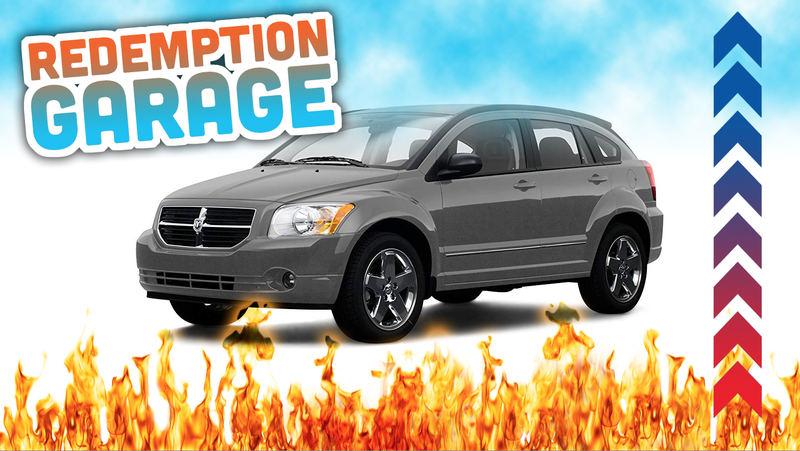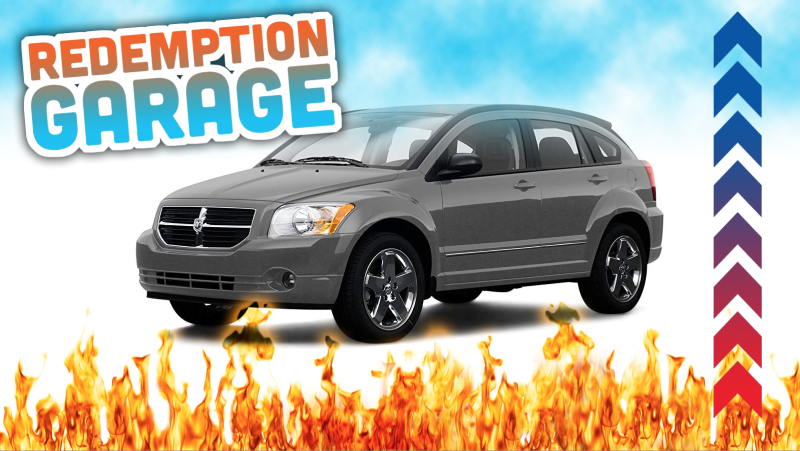
Today we ask an important question about the Dodge Caliber, a car that has spent over a decade squarely in the car world’s “shitbox” category: Has all of this time wallowing in its own mediocrity aged the Caliber like a fine wine into something that is, somehow, not bad?
This is a bad take that I’ve wanted to write for the longest time, and with the retirement of Jalopnik’s beloved Meh Car Monday series—it is our position that we have named all the Meh cars and have nowhere to go from here—and the birth of a new series called Redemption Garage, where we ask readers if certain crap-cans should be forgiven, I finally have that chance.
I think the Dodge Caliber is so bad that it’s good, in much the same way as a Yugo GV or a Ford Pinto is now good after spending years in the dark cells of Bad Car Prison.
No, it doesn’t have the cool fiery-crash story of the latter or the intriguing communist background of the former, but it was so bad and quirky, that it deserves redemption.
The problems with the Caliber were numerous when it came out in 2006, sitting on a platform developed in part by Mitsubishi that many reviewers at the time said didn’t handle well at all. The Truth About Cars was particularly harsh, writing in its early 2007 review:
Despite an independent rear suspension, the car displays all the grace of a sumo wrestler on figure skates. At the risk of inflicting metaphor overload, the tiller provides less feedback than a bumper car, with precisely none of the fun. And when it’s time for the “fun” to stop, the base model’s rear drums sound the death knell for pre-disc technology; though hopefully not for the car’s occupants.
Advertisement
And here’s a short video review from Edmunds, which ends with the words “underwhelming performance overall”:
To be fair, a lot of the early Caliber reviews weren’t that bad, and it took a little while before the world considered it a true shitbox.
Advertisement
Heck, there were even some early reviews that were good, including this somewhat baffling, glowing write-up from Motor Trend—an article that actually includes the phrase “The CVT is a joy,” and continues with this paragraph, which—in hindsight—I bet the author wishes he could take back:
The Caliber is a huge step forward for Chrysler. It moves well ahead of American-branded compacts and will be competitive with the best Japanese nameplates as well. It’s roomy, aggressively priced, and current from a technological standpoint (save for the lack of that much-in-demand hybrid version). The packaging offers several unique aspects and includes some fun creature features. A job well, if not perfectly, done, as this market segment and its buyers don’t tolerate excuses.
Anyway. According to Good Car Bad Car, the Caliber sold okay for the first three years, but still much worse than the car it replaced, the Dodge Neon, which bowed out after the 2005 model year. After those initial years, though, Caliber sales figures dropped to a downright sad level, and that’s even with the Cash for Clunkers program of 2009, under which, according to Allpar, the Caliber was one of the top vehicles purchased.
Advertisement

Having driven my brother’s 2007 Dodge Caliber, I can say that the main issue with the car wasn’t the handling or the 2.0-liter “World” engine, which made 158 horsepower (a 148 horsepower 1.8-liter and a 172 horsepower 2.4 were also available), it was the optional CVT, which was hilariously loud and just generally unrefined, pushing the engine speed all over the tach with a buzzy-ness that reminded me of a snowmobile or ATV.

Advertisement
Worse was the fact that the Caliber was an economy car in a lineup of Daimler Chrysler products that were pretty much all filled with hard, bland interiors. Sit in a 2007 Jeep Grand Cherokee, a fairly premium vehicle considered near the top of Chrysler’s hierarchy at the time, and you’ll be surprised by how bad it is (to be fair, other automakers’ interiors weren’t great back then either, but Daimler Chrysler’s were at the bottom). So you can just imagine how nice the company’s cheap little $13,985 entry-levelDodge’s insides were.
Prior to the Caliber’s 2010 interior refresh, the plastics on the inside of the little hatch felt and looked like melted down McDonald’s Kids Meal toys that had been painted gray. And I mean gray.
Look at this depressing interior; There’s not even a bezel at the base of that door lock knob; they just drilled a hole into the door plastic and called it good:

Advertisement
This was all happening in the middle of DaimlerChrysler’s “Material Cost Management” initiative, which basically was all about reducing vehicle cost, but doing so on “class A” surfaces that people see and touch was what turned the Caliber from bland and forgettable, to downright pathetic.
To be fair, Dodge tried its best to spice the car up, but mostly with gimmicks, like the “Chill Zone” beverage cooler in the glovebox:

Advertisement
And the little flashlight built into the dome light:

Then there was the drop-down speaker, called “MusicGate Power,” in the rear hatch:
Advertisement

Oh, and there were the illuminated cupholders and an iPod holder in the armrest, which—to its credit—could slide fore and aft to accommodate various human body sizes:

Advertisement
Dodge also offered a bigger screen, as well as color inserts for the seats, and a big color center stack trim piece:

It is these often-considered-bad traits—the terrible gray and hard interior, the weird buzzy CVT transmission, and the gimmicky features—that give the Caliber character, and character is the one thing that can quench a vehicle once engulfed in the fiery furnaces of Bad Car-dom, and allow it to finally enter the realm of “cool.”
Adding to those points is the styling. Dodge advertised that it’s “anything but cute,” but I disagree. The Caliber is definitely cute, with the aggressive wheel arches, big grille, and giant taillights making it seem like a tiny hatchback in the middle of a growth spurt into an SUV.
Advertisement
It’s kind of dorky, but it’s not boring, and I dig that.

And then there was the SRT model, with its big wing, nice aluminum wheels, sweet hood scoop, and unique lower fascias and side skirts. Plus there were changes to the suspension and brakes to make them a bit better for track use, and a manual trans with sixth gear came onboard. More importantly, the Caliber SRT-4 got a turbocharged version of the 2.4-liter World Engine, pumping out a brutal 285 horsepower and 265 lb-ft of torque to the front wheels. It’s like a Mazdaspeed 3 for someone who boldly declared, “You know what this thing needs? MORE torque steer.”
Advertisement
Even more, the Caliber SRT-4 was dirt cheap, costing about $23,000 back in 2007, and a desire to keep costs down almost certainly played a role in the fact that the this front-drive monster sent torque through an open differential.

To combat excessive wheel spin and torque steer, there was a pseudo “limited-slip” setup that relied on the brakes, and Dodge actually had to limit torque in the first two gears. Per Motor Trend:
Plant your right foot to the floor and call up all the Dodge Caliber SRT-4’s torque, limited to 214 pound-feet in first gear… At least there’s no excessive squat, so the nose is steady as you shift to second for 245 pound-feet, and then through third, fourth, fifth, and sixth, where you get all 265 pound-feet.
Advertisement
What an absurd machine that thing was. But, as our friend Doug DeMuro has written, it was kind of cool.
Anyway, with that I’m going to rest my case. Today’s inmate locked away in Bad Car Prison is the Dodge Caliber, and I, for one, think its quirky maladies are what make it eligible for an early parole.
Jason Torchinsky’s Take

Advertisement
I’m not going to lie: this is a tricky way to get this series started. Do I really think the Dodge Caliber deserves redemption? I’ll admit, I’m not sure I’ve ever looked at one of these with anything that even remotely resembles fondness, or desire, or, hell, even interest. But David makes some compelling arguments here, so I’m going to give it a try.
Trying to look at this thing objectively, I suppose I like the sort of cartoonish proportions and the exaggerated wheel arches and flared fenders. It’s not completely anonymous and boring-looking, so that’s a plus.
I like the gimmicks, too—the white gauges, the little flashlight, the sort-of drink cooler, the flip-down speakers—these are the sorts of details that can make an otherwise ignorable car a little bit more endearing, if you happen to own one or encounter one out there in the world.
Advertisement
I don’t think I can meet David all the way to “good” for this thing, but, I think I can come to something along the lines of “not miserable.”
Unless it has that CVT. I wouldn’t wish that hunk of crap on Stalin’s ghost.















